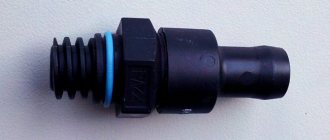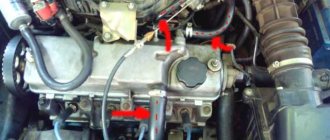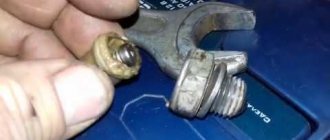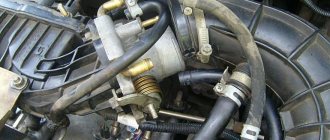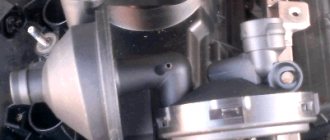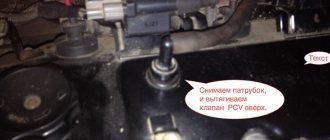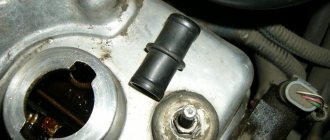The crankcase gas cleaning system is the simplest and lightest thing in the engine. And, meanwhile, it needs increased attention from the driver. We are talking about constant care: inspection, cleaning and testing of the system; you also need to pay special attention to the crankcase ventilation valve (CVG).
Preventing the release of gases containing the entire periodic table is the main task of this system. Its device is designed not only to keep the surrounding area clean, but also to reduce the result of gas pressure on internal combustion engine parts to a minimum value.
What is the purpose of and where is the crankcase ventilation valve (CVVV) located?
The crankcase ventilation valve is needed to pass exhaust gases that accumulate in the engine crankcase back into the combustion chambers of the cylinders through the intake manifold. The KVKG is usually located in the intake manifold. There are two types of crankcase ventilation: forced and non-forced.
Diagram of the crankcase ventilation system
How to detect ventilation problems
When the ventilation system becomes clogged, gases stop being released normally. Resinous deposits form, interfering with the removal of vapors. The following manifestations of the problem are possible:
- Leaks and excessive oil consumption.
- The oil in the sump can be sucked in through the valve. This leads to valve deformation.
- Possible engine smoke.
- Deterioration of engine dynamics.
- Extraneous sounds in the valve and intake manifold area.
- The idle air control and throttle valve become dirty too quickly.
- If the system is severely clogged, crankcase gases pull out the dipstick.
Design of a crankcase gas purification system in modern cars
Crankcase gases, while passing through a simple system of special valves and tubes, exit back into the combustion chambers, where they are burned out.
Diagram of a crankcase gas cleaning system with a cyclone oil separator (1 – crankcase gas supply pipeline; 2 – air intake pipeline; 3 – membrane; 4 – compression spring; a – open position of the valve; b – closed position of the valve)
First, the gases exit into the oil separator, which is directly attached to this hole. The entire network of gaskets and baffles of the oil separator is designed to separate oil droplets from the gas mixture, which return to the sump. This function is useful because it reduces oil consumption. In different models, the oil separator is either built into the engine, or is placed under the valve cover and forms a separate unit.
Engine troubles
Everyone has heard this word “triple”. But not everyone fully understands what this word means. But this term was coined precisely in our country to designate a common problem. The fact is that sometimes one of the cylinders in the engine begins to malfunction or completely stops working. The mixture of air and fuel in it either burns poorly or does not burn at all. As a result, only three working cylinders remain. Hence the word “triple”.
The driver understands that this problem has arisen by how much the engine begins to vibrate. There is a feeling that he is ready to break free of his fastenings. In this case, the car does not move. Sometimes you can hear fuel flashes that pop into the muffler.
If the VAZ 2106 is tripping, there may be three reasons for this:
Less or more air enters the cylinder than necessary. This may be due to loss of air tightness in the air system. We check whether the system is leaking air somewhere. To do this, use a compressor to pump air into the system to increase the pressure and listen to where it hisses. If there is no hissing, then the system is still sealed. You also need to check if the air filter is clogged. The air supply dampers may also be faulty.
Particular attention should be paid to the throttle valve. More or less fuel enters the cylinder than necessary. This is checked by measuring the pressure in the fuel system
If the pressure is low, you need to look for a problem in the fuel pump and in the pressure valve. If the pressure is normal, you need to diagnose the injectors for contamination or failure. Low compression. If this is the reason, then you need to prepare yourself for a long, expensive repair. Compression is reduced or reset if the piston burns out, the piston wheel wears out, or the valve malfunctions. To find out the true cause, you will have to completely disassemble the engine and troubleshoot it. Often you have to do major repairs.
Design and principle of operation of the crankcase ventilation valve
The ventilation valve has such a simple device that even a novice car enthusiast can easily learn how to disassemble and clean it.
Scheme of gas movement through the ventilation valve
It consists of:
- Plastic case.
- Lids.
- Inlet and outlet fittings.
- Two cavities.
- Membranes.
- Springs.
The principle of operation of the valve in modern cars
Video about the operating principle of the crankcase ventilation system and valve.
The ventilation valve opens in medium mode, when optimal pressure is created on the membrane. In this position, the valve overcomes the spring pressure. After passing through the oil separator, the gases are cleared of oil droplets, pass into the open valve and complete the cycle, returning back to the combustion chambers, where their combustion is completed. If we are talking about a non-forced crankcase ventilation system, then the valve almost does not open in idle mode and is closed at high speeds. At high speeds, a lot of gases are released, and hot gases often leak into the intake manifold. In this case, the valve is closed, since there is a risk of ignition of crankcase gases in the crankcase itself.
Operation of the crankcase ventilation valve in different modes
Where do the gases go if the valve is closed?
In any case, crankcase gases must be removed and under no circumstances remain inside the system. There is another iron pipe that leads to another valve. This is the so-called “fungus” or pressure reducing valve. When the main valve is closed (and this happens, let me remind you, at high speeds and at idle), the gases pass through this iron pipe directly into the “fungus”.
It also has two states: closed and open. When it is covered, a small calibrated hole inside it opens slightly, which allows the gas mixture to pass through. In this case, the gases escape through a large hole. That is, a system consisting of two valves ensures uninterrupted and reliable crankcase ventilation.
How the crankcase ventilation system works, what vile things to expect from it
What the engine crankcase ventilation system is designed for is clear from its name. But why does the crankcase need to be ventilated? As practice shows, the accuracy of the answer to this question greatly depends on whether one or another owner has previously had to deal with the problems that the ventilation system can create. If you haven’t, it happens that the car owner may not even know why the crankcase needs ventilation, as well as how it is implemented.
It all comes down to the breakthrough of gases into the crankcase. No matter how good the piston rings are, they cannot provide complete sealing of the space above the piston where the working process occurs. As a result, under the influence of high pressure, not only the combustion products of the combustible mixture penetrate into the crankcase from the space above the piston, but also some of the combustible mixture itself during the compression stroke.
If the escaping gases are not removed, the pressure in the crankcase increases, as a result of which the crankcase gases are able to squeeze out the oil dipstick with subsequent ejection of oil from the engine into the engine compartment and cause oil leaks along the gaskets and seals. Ventilation ensures the pressure in the crankcase is equalized with atmospheric pressure, which avoids these negative consequences of gas breakthrough. This is the main reason for equipping any engine with crankcase ventilation.
However, ventilation has evolved into a whole PCV (Positive Crankcase Ventilation) system thanks to ecology. Crankcase gases are toxic. Therefore, ventilation, which was once widely used using a breather with an exhaust pipe that vented gases from the crankcase directly into the atmosphere, was banned from about the mid-1960s, first in the USA and then in Western Europe.
Now open-type breathers can only be seen on gearboxes, transfer cases and other units, where their presence is due to the ability of air to expand from heating during operation of the unit, which increases the pressure inside the unit, which also risks squeezing out seals and causing leaks.
In closed ventilation systems, which are equipped with all modern engines, crankcase gases are diverted into the intake manifold and then returned to the engine cylinders. Closed systems do not communicate with the atmosphere, and therefore do not pollute the environment with hydrocarbon compounds - unburned fuel, products of incomplete combustion of fuel, oil vapors, which are saturated with crankcase gases, but allow them to usefully burn out in the cylinders.
But the advantages of closed ventilation are not limited to this. Open ventilation worked due to the vacuum generated at the cut of the exhaust tube, but a prerequisite for creating a vacuum sufficient for intensive ventilation was the movement of the car - the faster, the higher the vacuum. The operation of closed systems is ensured by a vacuum in the intake manifold, so ventilation begins to function immediately when the engine starts. At the same time, a small vacuum is created in the crankcase, which increases the reliability of the seals.
The disadvantages are the complexity of the engine design. A closed ventilation system requires channels in the block and cylinder head, as well as pipes and hoses through which crankcase gases circulate.
Crankcase gases contain an oil suspension, which must be separated in order to avoid high engine oil consumption due to waste and contamination of the power system components located in the intake tract. Therefore, an oil separator, sometimes also called an oil trap or sump, and channels through which the collected oil is returned to the sump must be provided.
In addition, the connection between the crankcase space and the intake manifold affects the operation of the engine due to a decrease in the vacuum in the manifold and the addition of a certain amount of crankcase gases to the air entering the engine cylinders, which varies significantly depending on the operating mode of the power unit.
Finally, for the normal functioning of the ventilation system, a supply of fresh air is required into the crankcase space, otherwise, instead of the increased pressure in the crankcase, which the ventilation is designed to combat, the opposite effect is possible - excessive vacuum.
These are general provisions related to ventilation systems, but as for their implementation on a particular engine, then, as they say, there are so many manufacturers, so many options. In addition, the performance is influenced by the environmental class of the power unit, the type of engine - gasoline or diesel, and the presence of turbocharging.
For example, oil separators can be built into the engine and located inside the valve cover or in the cylinder block, or they can be made as a separate unit located on the engine.
Oil separators use labyrinth and inertia principles to capture oil. In the first case, the flow of crankcase gases moves through channels that sharply change direction. In this case, oil droplets settle on the walls of the labyrinth, then combine into large drops and flow down, where they fall into the drain channels and return to the engine sump.
In centrifugal oil separators, oil droplets are thrown back under the influence of inertial forces and stick to the walls, and then flow down again.
The methods of coordinating the operation of the ventilation system with the operation of the engine are also different. In carburetor engines, engines with single injection and often with distributed injection, the issue was resolved using two channels for supplying crankcase gases, one of which was discharged in front of the throttle valve, and the second, ending in a calibrated hole (nozzle), behind it. When idling, the gases flowed through the channel with the jet behind the throttle valve, but when, as the throttle valve opened and the crankshaft speed increased, the vacuum behind the valve decreased, but the amount of gases that broke into the crankcase increased, which is why this channel ceased to cope with with its responsibilities, the first channel came into play.
However, valve control systems are most widely used. In them, the flow area in the crankcase gas supply line is changed using a valve in inverse proportion to the vacuum in the intake manifold - the stronger the vacuum, the smaller the valve flow area and vice versa.
PCV valves, in turn, come in spool and diaphragm types. From the point of view of more accurate dosing of the amount of crankcase gases, membrane ones are considered the best, but, however, this is not so important. It is important that a valve malfunction leads to a violation of the composition of the combustible mixture. This is where the problems that crankcase ventilation can create in operation begin.
Valves, as you know, can lose mobility or, to put it simply, get stuck in some position. For diaphragm valves, the reliability and durability of the diaphragm material are also questionable. The valve may jam due to clogging. Crankcase gases contain fine particles of soot and carbon deposits. The worse the technical condition of the engine, the more there are. Again, small droplets of oil may contain even smaller foreign inclusions. The worse the engine is maintained, the more inclusions there will be. This dirt is deposited not only in the PCV valve, but also in the calibrated holes and pipes of the ventilation system. Again, the pipes can burst - their material is by no means eternal.
The insidiousness of the ventilation system lies in the fact that problems in it may not have a very noticeable effect, and if they begin to affect a decrease in power, an increase in fuel consumption, too rapid contamination of the throttle valve, idle speed regulator, oily air filter and other problems, then they are written off for malfunctions of other systems, primarily power and ignition systems.
According to experts, some engine models that meet environmental requirements from Euro-4 and higher, if there are problems with ventilation, can “fall” into emergency operation, however, even in this case, computer diagnostics do not indicate the true culprit. Therefore, most often, only when the system is so clogged that crankcase gases have no choice but to squeeze out the oil dipstick and expel oil from the engine, they finally pay attention to ventilation.
But during the winter period of operation, ventilation is capable of real meanness. In addition, crankcase gases contain water vapor. Where do they come from? From the atmospheric air entering the engine, of course.
Moving through the system, steam can condense in “nooks and crannies”, after which, at low ambient temperatures, the moisture changes its state of aggregation, turning into ice. This, in turn, clogs some “bottleneck” of the system. Again, crankcase gases have no choice but to squeeze out the oil dipstick and begin to expel engine oil out. Moreover, while clogging of the ventilation system with carbon deposits can be expected indefinitely if the power unit is working properly and is being serviced in a timely manner with high-quality consumables, freezing is a matter of a very short time.
The problem of freezing is known to engine developers, as evidenced by the presence of heaters built into the ventilation system. In the diagram above of the ventilation system of 1.6 and 2.0 TDI Volkswagen diesel engines, the heating function is performed by a heating resistor. Unfortunately, these heaters are often equipped in the crankcase ventilation of only those engines that are intended for cars sold in countries with cold climates - the so-called northern version. If heating is not provided or it is faulty, expect surprises.
And again, unfortunately, not all operating instructions contain instructions on how to care for the crankcase ventilation system. It should consist of periodic cleaning of the cavities of the ventilation hoses, oil separator, calibrated holes and other bottlenecks in the system.
At the same time, existing care instructions recommend that system maintenance be carried out simultaneously with the next engine oil change or after one replacement. However, how often are such recommendations used at service stations, in garages, by owners who independently service their cars? As philosophers say in such a situation, there is always a probability, in this case it is zero.
Sergey BOYARSKIKH Photo by ABW.BY
We thank the Resource Center on the basis of the Automotive College named after Academician M.S. Vysotsky for their help in organizing the photography
You can find and buy the necessary spare parts by using the search aggregator site BAMPER.BY. Here we have collected more than 287,000 offers from the largest Belarusian suppliers with photographs and the price of each part. Search for any spare part in three clicks.
What are valve malfunctions?
The presence of a malfunction can be determined by its characteristic symptoms.
- Oil splashing and increased oil consumption.
- Filter dirty.
- The engine does not start at full power or you can hear a slight whine from the engine.
Basic malfunctions.
- The valve and membrane are dirty.
- Exhaust openings and pipes are dirty.
- The membrane has worn out and flattened.
Crankcase gases are usually not completely released from the oil in the oil purifier. All components of the system - membranes, pipes, valves - become dirty and clogged with oil soot. If the driver does not take the time to clean them, the crankcase pressure increases. A strong smell, burning and soot appears when the engine is running. You may notice that oil consumption increases. When a valve fails, oil pressure increases and is forced past the seals and gaskets.
Valve wear is also characterized by a decrease in engine power. In this case, the pressure in the exhaust system increases or even the operation of the internal combustion engine stops completely. If the damaged valve is not completely blocked by the membrane, then oxygen entering the combustion chamber will help the engine fail.
The engine smokes
Usually a small amount of smoke comes out of the exhaust pipe. However, sometimes there come moments when thick smoke can literally pour out of your six
To understand what the problem is, you need to pay attention to its color
Transparent color. Transparent or slightly white smoke that is almost invisible. It's not even smoke, but rather steam. It occurs because the system has not yet warmed up. This is especially noticeable in winter after the car has been sitting in the yard all night. There's nothing wrong with that. After the system warms up, the steam will practically disappear.
Black color. This phenomenon looks quite scary. One of the reasons may be the usual overload of the motor with heavy weight. Try unloading the trunk if you have placed something particularly heavy in it. However, most often this problem does not arise for VAZ 2106 owners due to the small size of the vehicle
Therefore, also pay attention to how the mixture formation process proceeds. Most likely there is too much fuel entering the engine
The result is not only black smoke, but also increased fuel consumption. Try changing the air filter. You also need to measure the compression. Check the condition of the cylinders and whether the engine control sensors are working correctly. Check the spark plugs to see if they have a black coating on them, which may indicate the need to repair the engine.
White color. Unlike the clear smoke described above, this smoke has a thick white tint and does not disappear as the engine warms up. It indicates that there is a malfunction in the cooling system. This is a sure sign that urgent measures need to be taken, because a breakdown can lead to a major overhaul of the engine. Check the candles to see if they have developed a coating similar to what appears on a kettle due to scale. If this happens, it means water is getting into the cylinders.
Bluish color. The reasons for this phenomenon can be various breakdowns. For example, you can check the serviceability of the valve stem seals. If they are damaged, oil may leak and enter the idle engine. You will also have to check the oil rings. Due to their wear, excess oil may flow into the cylinders.
Advantages and disadvantages of the crankcase ventilation system
The crankcase ventilation system was constantly modified with the improvement of mechanical engineering. Modern systems often cause confusion among drivers. It all started with an ordinary pipe that led under the car and ends in modern cars with advanced systems with oil separators and valves of various types. The most modern, closed-type forced system has the following advantages:
- Minimizing the release of harmful substances.
- Oil seals and gaskets are not squeezed out due to the effective reduction of pressure inside the crankcase.
- The service life of the engine oil increases.
- Atmospheric air, dust and moisture do not enter the crankcase.
- Good engine output.
What are crankcase gases
During operation of the internal combustion engine, high pressure is formed inside the cylinder. During combustion of the air-fuel mixture, exhaust gases partially break through the piston rings and penetrate into the crankcase cavity. When gasoline burns incompletely and during the compression stroke, fuel, oil, and water vapors also enter the crankcase.
All these gases are collectively called crankcase gases. When they accumulate, the pressure in the crankcase increases, and the side effect is accelerated engine wear. There is also dilution and deterioration in the quality of the engine oil.
Methods for checking crankcase gases
It is necessary to open the cover on the hood and unscrew the oil filler cap, but do not unscrew it completely and remove it. Next you need to start the engine and see what happens to the cover:
If it jumps but doesn’t fly off, it means there is pressure and gases are escaping. This is fine.
When discharged, the cover suctions, this indicates problems with the intake manifold. In this case, a vacuum is created in the crankcase.
When it is thrown up strongly, this phenomenon means that the rings have sagged.
The second diagnostic method is to start the engine and open the lid completely. If it sticks slightly during removal, then the ventilation is working properly. When the suction is too weak and smoke comes out of the neck, this indicates a failure.
A lid that suctions too tightly is also a sign of failure. Most likely, the valve is leaking because its membrane is damaged. If, while the engine is running, oil splashes from under the cap and flows through the injectors, a major overhaul may be required. Such problems usually occur on cars with high mileage and a worn-out engine.
The third method will give results if the system is heavily clogged. You need to start the car and remove the dipstick. The engine is considered to be operating properly when a slight suction is felt when plugging the dipstick hole. If smoke appears, the mechanism is faulty.
Checking with a balloon
This technique is used with muffled ventilation. It is necessary to remove the oil dipstick from the tube. Then a balloon or medical glove is put on it and secured with electrical tape. You can also put it in place of the filler plug, but then you will have to make sure that the ball does not get sucked inside.
Next, start the engine, at minimum speed in idle mode, the ball should inflate slightly and stop.
When within 5 minutes the balloon hardly increases in size or inflates too much, this means that the ventilation is clogged and is working poorly. The piston rings may be worn out.
It happens that the ball stops increasing in size when the plugs are installed. This means that you will have to disassemble the system and see which element is clogged.
To check the functionality of the valve, clamp the tube forcefully with the engine running. If a click is heard at the moment of compression, the element is working properly. Another option is to hold a piece of paper over the flap. The leaf should float in the air under the influence of gases. If you put it over the hole, it will be attracted.
How often should cleaning be performed?
If the ventilation system is clogged and its filter is unable to clean the mixture passing through it, then not only unburned gases, but also oil particles and other pollutants will enter the engine. All this will ultimately have a negative impact on both the operation of the engine and its remaining service life.
The frequency with which the crankcase ventilation of the VAZ 2114 should be cleaned directly depends on the condition of the engine. So, if the car just recently came off the assembly line, and its engine has not clocked up 50,000 km, you shouldn’t even think about cleaning it, since the piston rings are still new, and there is practically no leakage of gases through them.
Valve cover of VAZ 2114 engine
The first cleaning (as recommended by AvtoVAZ itself) should be performed after the car has covered 60,000 km. And all subsequent cleanings should also be performed after every 60,000 km.
Many owners of domestic cars with extensive experience say that 60,000 km is too much, and cleaning should be done at least every 30,000 km - this will help avoid many problems with the engine and extend its life. In this case, the first cleaning should be carried out after the first 60,000 km.

